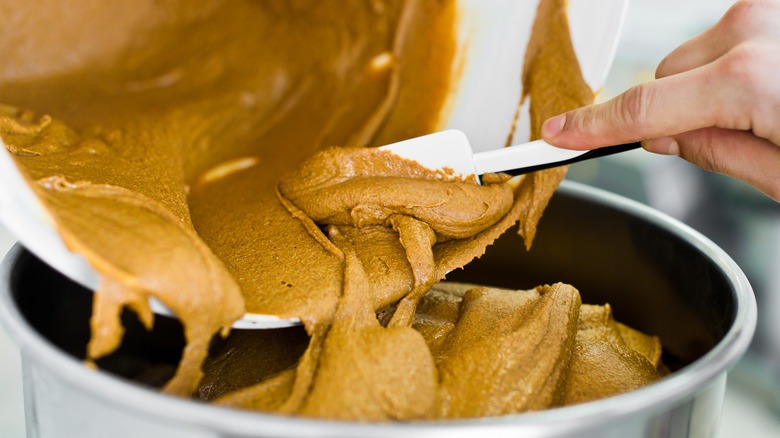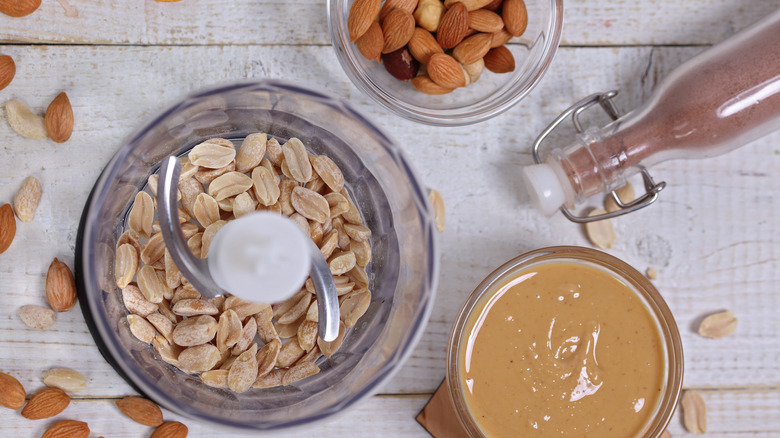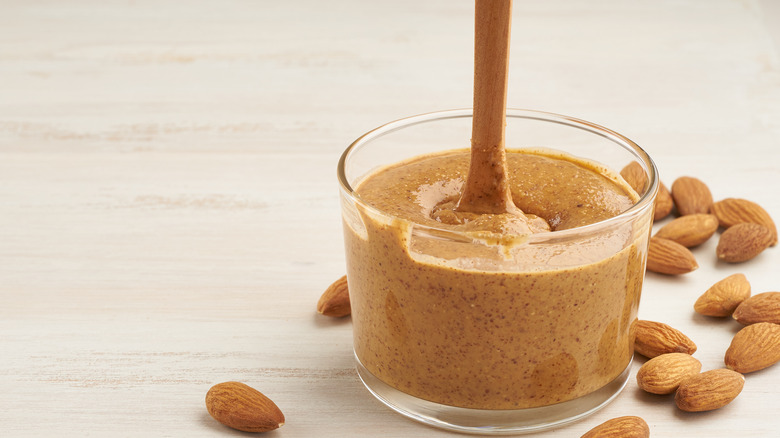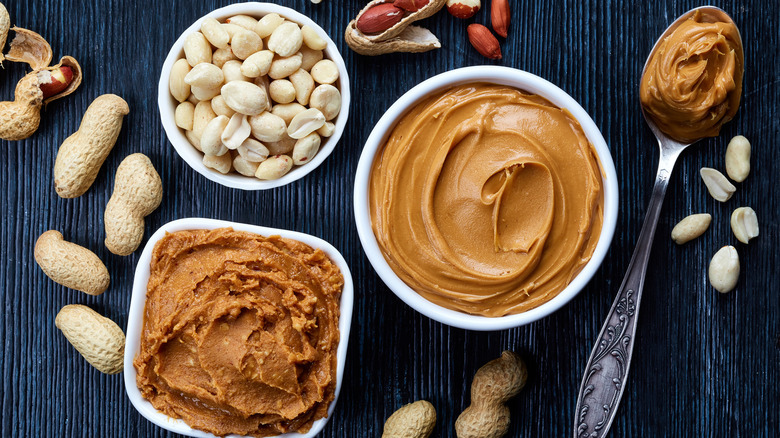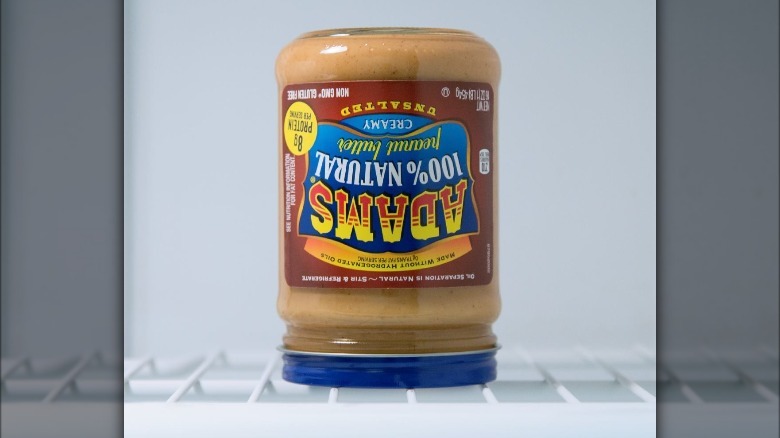11 Tips You Need When Cooking With Nut Butter
Peanut butter and jelly sandwiches are a childhood favorite and a filling snack or lunch in a pinch. However, the world of nut butters has widely evolved since you were a kid — and your palate probably has too. Beyond using nut butters as a simple spread, there are plenty of ways to expand your cooking repertoire. While peanut is the most common option in grocery stores, the selection has expanded to include pretty much any type of nut. Thanks to their high oil content, nuts can be blended into nut butter with relative ease.
Since many people stick to spreading the stuff on toast, it's worth exploring some tips to keep in mind when cooking with nut butter. It may seem like a standard ingredient, but the various textures and potential additions can play a role in the final outcome. Whether you're keen to whip up a batch of peanut butter cookies or want to make a cashew butter dipping sauce, we've got the scoop so you can rest assured you're guaranteed success.
Don't shy away from making your own
Making your own nut butter might seem on par with preparing pie dough from scratch or baking home-fermented sourdough bread. As long as you have a decent food processor or blender, it's far easier and less time-consuming. More importantly, making homemade nut butter gives you control over the final product. As Red Gate Bakery founder and baker Greg Rales notes, the result is far more customizable from the taste to the texture (via The Manual).
For starters, you can choose the type of nuts, whether they're roasted or salted, the level of creaminess, and any other ingredients to add. Try mixing different varieties of nuts for a complex flavor, or note the differences in taste between roasted and unroasted versions. You can also add sweeteners (sugar, honey, maple syrup, etc.) or sprinkle in salt for an extra salty twist. Finally, ingredients like cocoa powder or spices can seriously enhance your nut butter game.
To whip up a basic peanut butter recipe, dump a few cups of peanuts (or any nut) into a blender or food processor and grind them on high to produce a sandy texture. Then, scrape down the sides with a spatula and keep processing the mixture until the natural oils are released and the contents turn into a creamy paste. If you're having trouble or want to speed up the process, a splash of neutral-flavored oil will help. Blend in any extra flavorings and you're done.
Use it for more than just baked goods
There's no arguing against the delicious nature of a peanut butter cookie, but if you've halted your experimentation here, you'll want to branch out. Almond, peanut, cashew, and other nut butters are savory ingredients on their own. It's often only by adding sugar or pairing them with chocolate and other sweet foods that they take on an identity as a dessert.
While it might not show up as a jar of Skippy or Jif peanut butter, various countries incorporate ground peanuts into recipes. According to Thai cookbook author Kasma Loha-unchit, using peanut sauces in Thai dishes such as pad Thai and satay stems from Malaysian and Indonesian influences. Over in West Africa, peanut stew is a popular hearty meal.
If it's your first foray into cooking main courses with ground nuts, look to recipes from other cultures for a foolproof introduction. Once you get a taste for it, experiment with incorporating nut butter into sauces, stews, soups, marinades, and dressings.
Regularly stir the oil in natural nut butter
While you might be tempted to pour off the layer of oil on the surface of a jar of nut butter, you'll be doing yourself (and the remaining contents) a disservice. As registered dietitian nutritionist Sherry Coleman Collins explains, standard peanut butter contains added hydrogenated oils to maintain freshness and prevent the existing oils from separating (via National Peanut Board). Although it's slightly counterintuitive, adding more oil gives the appearance of less oil.
On the other hand, the oils in natural nut butter are liquid at room temperature and rise to the top of the jar. Registered dietitian Amy Kubal tells Livestrong that mixing the oil back in with the nut butter makes it infinitely simpler to spread. And while the obvious presence of oil might be disconcerting, she notes it consists of beneficial monounsaturated fats.
Thankfully — especially if you're dealing with a brand new jar — there are some mess-free ways to stir nut butter. For starters, simply store your container upside down when you first purchase it. After a day or so the oils should be well integrated and you can store the jar right side up in the fridge so the oils remain combined. Beyond mixing by hand, you can also transfer the nut butter to a food processor or use an immersion blender. Although these approaches lead to smooth results, the cleanup might not be worth it.
Read the labels for added ingredients
Natural nut butter has the advantage of only containing nuts and occasionally salt. This means that you can have a pretty good idea of the taste since it isn't modified with added sugars, flavor enhancers, and oils. Unfortunately, our taste buds can get a little confused when sugar, salt, and fats are combined, making it hard to identify those components. Once you switch from standard to natural nut butter, the distinction becomes obvious.
You might not realize that a classic jar of Jif or Skippy peanut butter actually contains a couple of grams of added sugar per serving. As the Environmental Working Group (EWG) reports, products specifically made with a lower fat content are often even worse. Since fat provides plenty of flavor, it needs to be replaced with more sugar, salt, and assorted additives when it's reduced. Plus, the hydrogenated oils that prevent the oil in nut butter from separating should be consumed in minimal quantities, according to the American Heart Association. Ultimately, the natural stuff is ideal to work with when you want the final product to actually taste like nuts.
Know when to leave the natural stuff out of a recipe
It's easy to fall prey to the idea that everything labeled as natural is automatically better on every level, but that's not always the case when cooking with nut butter. Natural options provide the most unadulterated flavor, but they can be trickier to deal with given the tendency for the oils to separate. When it comes to savory sauces, stews, marinades, and other dishes, natural nut butter is ideal since it is essentially just ground nuts, which is the basis of many of these recipes.
Meanwhile, bakers will want to make sure their natural nut butter is properly stirred before measuring it out for baked goods. Otherwise, the relative consistency of oils and solids may not be appropriate for your recipe. In fact, some people agree that standard conventional nut butter is the only type you should use for cookies to ensure a delightfully chewy outcome.
Baking Bites notes that many recipes are not developed with natural nut butter, but a few basic adjustments can make either work. The outlet explains that you may need to bake cookies for a shorter amount of time since the natural oils make them spread out and crisp up more quickly. Consider popping the jar in the fridge to mimic a thicker consistency. As for the flavor, keep in mind that salt and sugar measurements may need to be modified if the recipe was designed for nut butter that is already sweetened and salted.
Try different types of nuts
Peanut butter has long been an American staple (the product as we know it was invented in 1895, per National Peanut Board), but a wide range of other types of nut butter have become increasingly prevalent on supermarket shelves. With options like cashew, almond, hazelnut, walnut, and pecan among many others, there's no reason to limit yourself to peanut butter.
If you're just beginning your experimentation, a subtle swap like substituting peanut for almond butter in a cookie or muffin recipe is a good introduction. Similarly, blending cashew or almond butter into a salad dressing provides a rich creamy texture and nutty flavors that veer slightly out of the ordinary.
Also, consider that various dairy-free cheese alternatives make use of nuts like cashews, almonds, and macadamias — nut butter is just an extension of the same ingredient. If your stew or soup is lacking consistency or needs a punch of flavor to elevate it, nut butter will undoubtedly solve both issues.
Stir regularly when melting it to prevent burning
Depending on what you're making, a recipe may call for you to melt nut butter instead of simply using it straight out of the jar at room temperature. In this case, you'll want to tread carefully to avoid burning the nut butter or causing it to become too stiff.
Cooking Chew suggests a few basic methods to alter the consistency so that it becomes drippier and easier to mix into sauces or drizzle over food. Using a saucepan over a burner is an easy option, however, you'll have to keep the heat low and whisk the contents the whole time to prevent the nut butter from sticking to the bottom and burning. If you're aiming for a more liquid texture, it may be necessary to add a splash of water or milk to the pan. After about five minutes or once you're satisfied, remove the saucepan from the heat; there is a fine line between the perfect texture and having to start the process over again.
Melting nut butter in the microwave is another option, however, much like when you melt chocolate, the timing is crucial. Start with 20 to 30 seconds and stir between intervals until you reach the desired consistency. Be sure to use the nut butter immediately once it is melted or else the texture will soon begin to change as it comes back to room temperature.
Play with textures
The chunky versus smooth debate has people firmly planted on either side. When it comes to cooking with nut butter, sticking with one option or the other seriously limits your culinary possibilities. In some cases, a recipe will explicitly call for one texture, so you may want to follow the recommendations for the best results. However, in most situations, using what you have on hand or mixing it up based on your current desire will yield an equally delicious outcome.
If you're blending up a sauce or salad dressing, you'll obtain the creamiest results if you start off with a smoothly processed nut butter. Using chunky nut butter in those exact instances will be just as flavorful, and you'll have the bonus of an added crunch. Consider a plate of pad Thai, which often incorporates peanut butter and chopped peanuts sprinkled on top. The juxtaposition of the nutty flavor with and without a textural element makes it that much more enticing to eat. And if you're making your own nut butter from scratch with a basic food processor, there's no need to burn the motor trying to achieve the creamiest product — some extra bite is welcome.
Use cooking spray to simplify cleanup
We're always eager for hacks in the kitchen, especially when they pertain to clean up. If you have a large stock of measuring cups and a dishwasher, you won't understand the annoyance of having to rinse and dry out your equipment as you're simultaneously trying to follow the steps of a recipe. Considering the oily sticky consistency of nut butter, it's one of the worst culprits to clean. Plus, scraping it out of the measuring cup requires a few passes with a spatula to get it all out.
Thankfully, there is a solution to this problem. We recommend following this simple trick to prevent ingredients from sticking: Simply coat the inside of the measuring cup with cooking spray, and the nut butter won't cling to the sides. If you don't have cooking spray, a thin layer of neutral oil will offer the same result. You can also line your measuring cup with plastic wrap as an alternative, but that might be a bit messier in the long run.
Use near-empty jars as the foundation for recipes
It's normal to want to get every last bit of nut butter out of the jar, but we have a better suggestion than scraping it out with a spoon or spatula. Instead, how about adding other ingredients and preparing something directly in the container?
To be clear, this isn't a good idea if the bottom of the jar has bits of jam, butter, and bread from overzealous double dipping. However, the sticky remnants of your favorite nut butter are an excellent foundation for overnight oats or chia pudding recipes. These tasty breakfasts or snacks are a favorite for meal preppers since you premix your ingredients in a container and let them sit. With your choice of milk, seeds, oats, fruit, and other flavor enhancers, you'll have no trouble mixing in the rest of the nut butter.
You might also consider pouring a drink like hot chocolate or a milkshake into the jar to mix in some nutty flavors. Ice cream sundaes or a simple mug cake are other ways to satisfy your sweet tooth while finishing off a jar. Meanwhile, if you're craving something salty, consider whisking ingredients in with the nut butter to make a sauce for noodles or a salad dressing. Soy sauce, vinegar, lemon or lime juice, and liquid sweeteners like maple syrup are some options, and a splash of water will quickly dilute the consistency.
Store nut butter correctly for maximum freshness
Tips for cooking with nut butter are useless if the primary ingredient you're working with is not fresh. If you're dealing with classic options like Skippy or Jif, the National Peanut Board recommends keeping an open jar in the pantry for no longer than two to three months, then refrigerating it to keep it fresh. Remember that conventionally processed nut butter contains hydrogenated oils that help keep the natural oils stable, increasing the shelf life.
However, since natural products don't contain any added ingredients for preservation, the oils can become rancid in the wrong conditions, as food safety expert Marc Sanchez explains to HuffPost. He notes that unless you're using up your jar within a few weeks, you'll want to refrigerate it. This is especially relevant if you or anyone consuming the nut butter in question have a habit of double dipping, which can introduce bacteria. And to make everything easier on yourself, remember to store it upside down if the oil rises to the surface.
